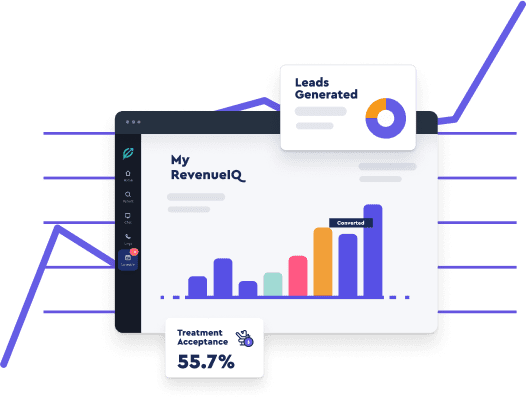Want Dental Office Communication Efficiency? Try 5 Tips!

Imagine this: A patient walks into your dental office, nervous about their root canal. The front desk forgets to inform the assistant that the patient has arrived, leaving her scrambling last minute to set up the room. Finally, the dentist walks in, unaware of the patient’s medical history update. Chaos, right?
Now, picture this instead: The front desk instantly updates the system. The assistant preps everything well in advance. The dentist reviews the latest patient notes before stepping in. The entire visit runs like a well-oiled machine.
That’s the power of seamless communication in a dental practice. Every role—from receptionists to hygienists to dentists—relies on clear, efficient messaging to keep operations smooth and patient care top-notch with clarity. Without it, schedules get messy, patients wait too long, and stress levels skyrocket.
In this blog, we’ll break down why strong communication is the backbone of a successful dental office. We’ll explore common roadblocks, simple yet powerful solutions, and the game-changing benefits of getting it right for achieving positive outcomes. Whether you’re a seasoned dentist or managing the front desk, these insights will help you build a practice where teamwork shines and patients leave with a smile (literally!).
Why Strong Communication is a Game-Changer in Dental Practice?
Think of a dental office like a perfectly choreographed procedure—when every step is clear and precise, things go productive. But when communication falters? That’s when appointments get mixed up, instruments aren’t ready, and patients feel confused about their treatment options. Here’s why effective communication, including the essential information, is the secret ingredient for a stress-free, high-functioning dental practice:
1. Smooth Teamwork = Fewer Headaches
- A well-informed front desk means no double bookings or surprise walk-ins throwing off the schedule.
- Dental assistants who get clear instructions can set up trays properly—no last-minute “Where’s the composite?!” moments.
- Hygienists who communicate patient concerns clearly to the dentist help ensure better treatment decisions.
When everyone’s on the same page, the office flows effortlessly.
2. No More “Oops, I Didn’t Know” Moments
- If a dental assistant doesn’t know a patient has allergies, it could lead to a reaction from a numbing agent.
- If the front desk forgets to flag a patient’s payment concerns, an awkward billing conversation might happen in the lobby.
Clear, consistent communication prevents these slip-ups and keeps operations stress-free.
3. Feedback That Actually Helps
- A dentist explaining to a new assistant why a specific instrument is used in a procedure boosts confidence and skill.
- A front desk manager giving clear feedback on how to improve patient interactions helps build a stronger team.
Encouraging open, constructive conversations makes everyone better at their jobs.
4. Listening Like a Pro = Happier Patients
- A patient nervous about a root canal isn’t just looking for technical expertise—they want reassurance. A calm, clear explanation makes a world of difference.
- Making eye contact, nodding, and showing empathy when a patient shares their concerns builds trust and comfort.
When patients feel heard, they’re more likely to follow treatment plans and return for future visits.
5. Clear Explanations = Confident Patients
- “You need a crown” sounds scary to a patient. But explaining, “Think of it like a protective cap for your tooth, just like a helmet for your head,” makes it easier to understand.
- Walking a patient through post-procedure care in simple, digestible steps helps prevent unnecessary follow-ups.
From keeping the office running like clockwork to ensuring patients feel valued and informed, strong communication makes all the difference. Whether it’s a quick team huddle before the day starts or a warm, reassuring chat with a nervous patient, the way you communicate shapes the entire experience. And that? That’s what sets a great dental practice apart.
5 Tips for Dental Office Communication Efficiency

A dental office without a proper communication system is like trying to do a filling without suction—messy, frustrating, and completely avoidable!
It’s not just about having the latest technology or fancy software; it’s about creating a system where every team member—front desk, assistants, hygienists, and dentists—knows exactly what’s happening, when it’s happening, and what needs to be done next.
Here are some tips to ace the same.
1. Implementing Communication Software Tools for Efficient Dental Team Communication
In today’s digital world, using the right tech can totally transform how your dental office communicates.
The right software doesn’t just make things easier—it makes everything run smoother. Think of features like:
– Automated appointment reminders
– Intra-office chat for quick team updates
– Easy tools to keep patients in the loop
These tools are built to boost efficiency and keep everyone—team and patients—on the same page.
Not sure where to start? Try scheduling a quick demo and see how it can help your practice.
Features of Effective Dental Office Communication Software
The implementation of software tools as a channel for communication is a game-changer for patient engagement in dental practices. Let’s explore some crucial features that make these tools a must-have for your setup:
- Real-Time Communication: Cutting-edge software offers an instant messaging feature to streamline intra-office communication. This real-time exchange of messages, whether via desktop or mobile devices, enhances workflow, coordinating various activities efficiently.
- Automated Reminders: Missed appointments can have adverse effects on a practice’s productivity. Software tools offer automated reminder features, ensuring that both the patients and the dental team stay informed about upcoming appointments.
- Customizable Forms: Personalized electronic forms aid in collecting essential data regarding patient history, allergies or other medical concerns, which helps to offer tailor-made treatment plans.
- Patient Portal: A secure platform for patients to review their treatment plans, adjust appointments, or communicate with the dentists bridges the gap between the patients and practitioners, nurturing lasting relationships.
- Data Security: These software solutions strictly adhere to HIPAA compliance, ensuring utmost data privacy and security.
Adopting dental office communication software ensures a seamless flow of information, paving the way for optimized operations and enhanced patient satisfaction.
2. Conducting Productive Morning Huddles
In a busy dental practice, efficiency is key, and starting the day with a productive ‘morning huddle‘ can set the tone for streamlined operations.
Kicking off the day with a quick team check-in helps everyone get on the same page. It’s the perfect time to go over the schedule, flag any concerns, and make sure each team member knows what’s ahead.
It’s not just about logistics—it sets a positive tone, encourages teamwork, and keeps the day running smoothly from the very start.
Best Practices for Engaging Team Members
To derive the maximum benefit from morning huddles, practicing certain strategies can help in engaging team members effectively.
- Timely Conduct: Ensure that the meetings begin promptly and staff adhere to the scheduled time. Regularity and punctuality instill discipline and respect for each other’s time.
- Clear Objectives: Clearly define the meeting’s goal, outlining the key discussion points. It helps retain focus, reducing distractions and irrelevant conversations.
- Active Participation: Encourage all team members to participate equally, expressing their expectations, concerns or ideas. This inclusive practice fosters a culture of open dialogue.
- Positive Ambience: Maintain a congenial atmosphere during the meeting. Chance remarks, shared laughter, or casual conversations can set a positive tone for the rest of the day.
- Actionable Conclusion: End the meeting with actionable steps, delegating responsibilities where needed, and confirming everyone’s understanding of the plan.
A concerted effort to conduct these meetings in an interactive, engaging, and time-efficient manner can work wonders in improving team synchronization, paving the way for a productive day ahead.
3. Organizing Regular Staff Meetings
Regular staff meetings (along with quick morning huddles) can seriously level up your dental office communication—if you keep them focused. Start with a clear agenda so things don’t go off track. Tackle high-priority topics first, like scheduling gaps or patient flow.
Make every point goal-driven—think “How do we cut no-shows by 20%?” instead of vague chit-chat. Take a moment to recognize team wins, too—a little shoutout goes a long way.
Keep it open so everyone can share ideas, not just listen. And always end with clear takeaways like “Miss X will update the script” or “Mr Y will price new supplies.”
When meetings are tight, purposeful, and positive, your team walks out aligned and ready.
Spark Honest Conversations and Feedback That Actually Help
Open dialogue during staff meetings is a game-changer.
When your team feels comfortable sharing ideas or concerns, you create a space that encourages learning, teamwork, and trust. It also helps catch small issues before they become big problems.
And let’s talk feedback—it’s not about criticism, it’s about growth.
When done right, positive, constructive feedback helps your team improve, feel heard, and stay motivated. It sends a clear message: every voice matters here.
Steps for Effective Feedback:
| Step | Detail |
|---|---|
| Create the Right Environment | Ensure a non-threatening, supportive space where individuals feel comfortable sharing their views. |
| Be Specific and Clear | Provide clear, specific feedback. Avoid vagueness that might lead to misunderstandings. |
| Be Constructive | Frame criticisms constructively, focusing on the issue, not the person. Offer suggestions for improvement. to help the recipient become a better communicator. |
| Show Empathy | Understand the feelings of the recipient and ensure your feedback is considerate and respectful. |
| Follow-up | Regularly follow up on the feedback provided. Monitor progress and provide further assistance if needed |
Open dialogue and constructive feedback create a vibrant environment where continuous learning, improvement, and mutual respect thrive.
4. Enhancing Active Listening Skills
Active listening is a game-changer in any setting—and dental practices are no exception.
It’s all about being fully present, making eye contact, nodding, and really showing you’re tuned in. Little things like paraphrasing what someone said can go a long way in making them feel heard.
It not only smooths out communication but also helps resolve conflicts with empathy and understanding. Strengthening active listening in your practice can boost teamwork, elevate patient care, and create a more connected, responsive environment.
What are the Best Techniques to Improve Active Listening in Dentistry?
Improving active listening comes with practice and intent. Here are a few techniques to enhance these critical soft skills in your dental office:
- Undivided Attention: When a team member or patient speaks, offer them your complete attention. Stay away from distractions like mobile phones or unnecessary workloads during the conversation.
- Non-verbal Signals: Display engagement through subtle body language—like maintaining eye contact, hand gestures, or nodding affirmatively. These signs reflect that you’re attentive and interested.
- Paraphrasing: Repeating or paraphrasing what has been said ensures you’ve understood correctly and shows the speaker that their message is important.
- Ask Clarifying Questions: If something isn’t clear, don’t hesitate to ask for clarification. It not only ensures accurate comprehension, but also demonstrates your interest and respect towards the speaker’s words.
Enhancing these skills in your team can tremendously improve communication efficiency, foster mutual respect and understanding, and elevate the standard of care provided to patients.
5. Ensuring Effective Written Communication in the Dental Office
Verbal conversations matter—but written communication is just as important in a dental practice.
Clear, well-structured written messages help document treatments accurately, support admin tasks, and even serve as legal records when needed. They’re also super handy for asynchronous communication, letting team members share updates and respond when it works best for them.
Bottom line? Strong written communication keeps everyone on the same page and makes your practice run smoother.
Important Tools and Platforms for Written Communications
Various tools and platforms are available that facilitate effective written communication within a dental office. Some of them include:
- Electronic Health Records (EHRs): These allow the dental team to digitally log and access patient histories, treatment plans, scheduled appointments, etc., enhancing continuity of care.
- Emails: Fast, efficient, and convenient, emails can be used for both internal and external communication, facilitating information sharing on the go.
- Software Applications: Various applications like Practice by Numbers provide features such as secure messaging, customizable forms, and automated reminders, significantly boosting internal communication and operational efficiency.
- Cloud Storage: Cloud-based platforms are perfect for storing important documents, contracts, training manuals, etc., allowing easy access, anytime, anywhere.
Employing these technologies ensures streamlined, efficient, and secure written communication, contributing to seamless operations in your dental office.
Common Communication Barriers in a Dental Practice (and How to Overcome Them)
Even in the most well-organized dental offices, communication hurdles can pop up, leading to confusion, delays, and frustrated patients. The good news? Recognizing these challenges and tackling them with smart solutions can make all the difference. Here are some of the most common communication barriers—and how to overcome them.
1. The Language Barrier
Not every patient will understand dental jargon, and technical terms like “periodontal disease” or “occlusal adjustment” might leave them feeling lost. When patients struggle to grasp their diagnosis or treatment plan, they may hesitate to move forward with necessary care.
Solution:
- Use simple, everyday language when explaining conditions and treatments. Instead of “You have gingivitis,” say “Your gums are inflamed, but with proper cleaning and care, we can reverse it.”
- Visual aids, models, and diagrams can be incredibly helpful in improving understanding.
- If necessary, consider translation services or printed materials in multiple languages to assist patients who speak different languages.
2. Time Constraints & Rushed Conversations
A packed schedule can make it tempting to speed through consultations, but when patients feel rushed, they may leave with unanswered questions or misunderstand key instructions. Similarly, team members might not communicate thoroughly when the office is in a hurry.
Solution:
- Allocate enough time for each appointment to allow meaningful discussions without feeling pressured.
- Train staff to provide concise yet clear explanations, ensuring that key points are covered efficiently.
- Use patient handouts or follow-up emails to reinforce important information shared during the visit.
3. Technological Hindrances
Technology is a fantastic tool for improving communication, but it’s not foolproof. Poor internet connections, outdated software, or a lack of training on communication tools can lead to miscommunication or delays in sharing crucial information.
Solution:
- Regularly update and maintain communication tools like scheduling software, email systems, and intra-office messaging platforms.
- Provide ongoing training to ensure all team members are comfortable using these technologies effectively.
- Have backup communication methods (such as a secondary phone line or manual scheduling system) in case of technical failures.
Ready to Turn Challenges into Opportunities with Practice by Numbers?

Effective communication is at the heart of every successful dental practice—it boosts teamwork, improves patient clarity, and keeps everything running smoothly.
That’s where Practice by Numbers comes in. Their smart, tailored solutions help break down common communication barriers and streamline daily operations, so your team stays connected and your patients stay informed.
Streamline Patient Communication: Miscommunication can lead to missed appointments and patient dissatisfaction. Practice by Numbers’ Patient Relationship Management system automates reminders, follow-ups, and outreach, ensuring patients are informed and engaged throughout their care journey.
Enhance Team Collaboration: Inefficient internal communication can disrupt workflow and reduce productivity. The Team Chat feature provides a cutting-edge internal messaging system that connects your team across multiple locations, fostering seamless coordination and reducing misunderstandings.
Optimize Appointment Scheduling: Managing appointments effectively is crucial to minimize no-shows and maximize revenue. Practice by Numbers offers customizable, automated appointment reminders via text, email, or phone call, helping ensure patients arrive on time and are well-prepared.
Modernize Patient Interactions: Traditional communication methods may not meet the expectations of today’s tech-savvy patients. With features like two-way texting and web chat, Practice by Numbers enables real-time, personalized communication, enhancing patient satisfaction and engagement.
By integrating Practice by Numbers into your dental practice, you can proactively overcome communication challenges, build stronger patient relationships, and create a more efficient, patient-friendly environment. Embrace these solutions to not only address existing barriers but also to unlock new opportunities for growth and excellence in patient care!
Frequently Asked Questions
What are the first steps to improve communication in a dental office?
Implement regular team meetings, establish clear communication protocols, utilize digital tools for efficient internal messaging, provide training on active listening skills, encourage feedback from staff. Foster a culture of open communication to enhance dental office efficiency.
Why is documenting communications important in dental offices?
Documenting communications ensures maintaining an accurate record of patient treatments, which aids in continuity of care, legal protection, and efficient administrative operations. It also fosters transparency and understanding among the team members about the patient’s condition and treatment plan.
How do communication tools impact the efficiency of a dental practice?
Communication tools like software applications facilitate real-time messaging, centralized record management, and automated reminders. This aids in streamlining operations, reducing potential communication gaps or misunderstandings, thereby boosting overall productivity and efficiency.




